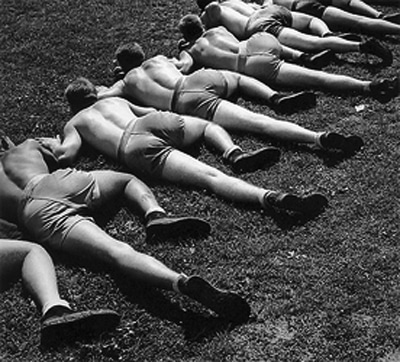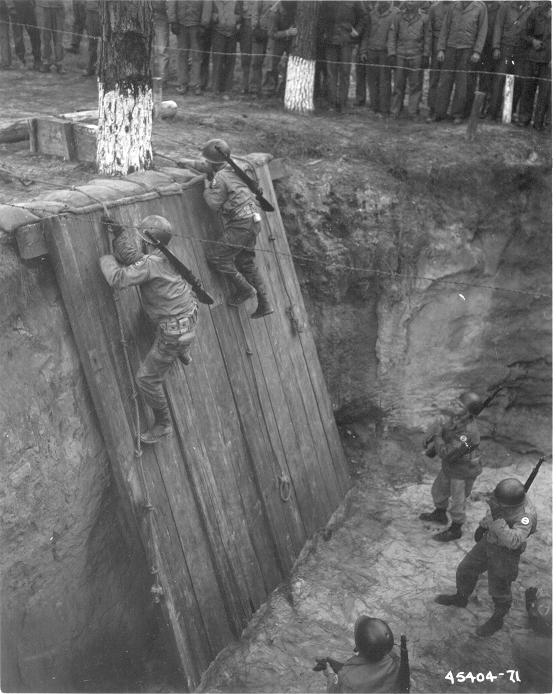
Editor’s note: This week we’re publishing excerpts from FM 21-20, an Army field manual from 1946 that includes the physical training program used by GIs during WWII. You can read the story behind FM 21-20 here. This series may offer you practical suggestions on exercises to incorporate into your own workouts, or simply inspire you to get in shape and embody the kind of strength and fitness that would make your grandpa proud!
Many men don’t find running enjoyable, but it served as the base for GIs’ cardiovascular conditioning. What’s interesting is that the running form the manual suggests is in many ways very similar to the form recommended currently, which is seemingly touted as a new discovery. But, as always, there’s truly nothing new under the sun!

FM 20-21: War Department Field Manual, 1946
Running and Grass Drills
RUNNING
TYPES OF RUNNING ACTIVITIES. Running is the most effective way of developing the circulo-respiratory endurance and it should be included in the physical training program every day. It may take the form of drill field running, road work, wind sprints, cross country running, or running the obstacle course. Grass drills and some types of games develop the same type of endurance and may be substituted for other forms of running.
GENERAL FORM AND TECHNIQUE.

Because many soldiers do not know how to run well, it is advisable to teach them the proper form at the outset. In running, as contrasted with the double time shuffling gait, the body leans slightly forward without bending at the waist. The head is erect, the knees lifted well out in front, and the toes pointed straight ahead. When the foot reaches a position about 18 inches in front of the center of gravity, the foot and leg are brought backward vigorously. The foot contacts the ground almost under the center of gravity, not out in front of the body. The runner alights on the balls of the feet, and not on his heels, unless he is running slowly and for a long distance (double timing).
When the runner lands on the ball of his foot, his heel immediately sinks to the ground. He then pushes off from the ball of the foot as his foot leaves the ground. The runner swings his arms from the shoulders. His elbows are bent at an angle of 45° to 60° from a straight line. The range of the arm movement is fairly short. It does not pass the median line of the body in the forward swing. However, the hand comes close to the median line just below the level of the chin in fast running. In the backward swing the arm does not go far past the hip. When the foot leaves the ground and starts forward, the heel is brought high beneath the hip, especially in fast running. The path described by the foot is an elongated ellipse. That is; the foot starts from a position underneath the hip, moves out and forward, then down and backward, contacting the ground. The slower the pace, the lower the foot on the forward swing. After the foot leaves the ground the heel immediately starts forward and upward. The knee action and the arm action should be free and smooth at all times. All muscles not used in running should remain relaxed.
ROAD WORK. Road work is a mixture of hiking and running which is used extensively in the physical training program, particularly in the early stages. Usually, the soldier begins with 100 paces at double time, and 200 to 300 paces at quick time. These proportions gradually change until the soldier is alternately running 300 paces, and marching 100 to 200 paces at quick time. The total distance should take from 10 to 30 minutes. The length varies with the stage of training of the soldier, and the speed of running. To make the demand more severe, increase the speed of running beyond that normal for double time.
WIND SPRINTS. Wind sprints provide an excellent means of giving a comparatively large number of men a strenuous workout in a few minutes. Parallel lines are drawn from 40 to 60 yards apart. The instructor takes up a position midway between the two lines. All the men are stationed behind one of the lines. The instructor calls out, “All men over 200 pounds take the mark” (any other convenient means of grouping men may be employed). Then, upon command (usually a sharp blast from a whistle), this group sprints at top speed in front of the instructor. He calls out the names of the men who pass by in first, second, and third places. The men then “coast” for an equal distance (slowing up gradually) and take their positions behind the other line. As soon as the first group has passed the instructor he calls for the next group, “men over 190” who race in the same manner. This process is continued until all men have sprinted past the instructor. The process is then repeated immediately with the men sprinting in the opposite direction. A hundred men can be given a strenuous workout in 5 minutes by means of this drill. The dosage can be regulated by increasing or decreasing the distance or the number of sprints, or both.
CROSS COUNTRY RUNNING. Cross country running is usually thought of as distance running over relatively rough terrain, where men run from the beginning to the end of the course. It may, however, include some walking, as in road work. Cross country running should not be confined to level areas, but should include running over hills and through rough country where possible. The group engaged in cross country running may range in size from a single platoon to a company. Leaders should be stationed at the head and the rear of the column, and every effort should be made to keep the men together. After the abilities of the men in cross country running have been determined, it is advisable to divide the unit into three groups. The poorest conditioned group is started first; the best conditioned group, last. The starting time of the groups should be staggered so that all groups come in about the same time. In preliminary training the running is similar to ordinary road work in that it begins with rather slow jogging, alternating with walking. The speed and distance of the run is gradually increased. As the condition of the men improves, occasional sprints may be introduced. During the preliminary stages of cross country running the distance is short (from 1/2 to 1 mile). It is gradually increased to 2 or 3 miles. On completing the run, the men should be required to continue walking for 3 or 4 minutes before stopping, to permit a gradual cooling off and return to normal physiological functioning.
GRASS DRILLS
GENERAL.
a. Grass drills are vigorous exercises, involving going to the ground and getting up, interspersed with either short sprints, vigorous stationary running, or other exercises. These drills are strenuous and should not be continued for more than 2 or 3 minutes during the early stages of the conditioning program. They may be carried on for about 5 minutes after the men have become well conditioned. After several minutes of marching or other mild exercise they may be repeated.
b. Grass drills should be executed vigorously and quickly. The commands should be given in rapid succession. All of these exercises demand considerable endurance, and the men should be required to keep driving even after they become tired. Grass drills should continue until there is real respiratory distress.
c. The commands used in conducting grass drills are informal and do not include the usual preparatory command. The men execute the command immediately upon hearing it. These are drills of alertness and quick response, as well as of conditioning. Since one purpose of this drill is to develop alertness and quickness in following commands, there should be no set sequence of movement. Rather, the order should be varied so that the men will not be able to anticipate the next movement.
d. The basic exercise in grass drills is running. Most frequently this is stationary running, or running in place. The men sprint vigorously swinging their arms hard as in running, and raising their knees above the hips but without forward progress. If actual sprint running is used, the men sprint 10 to 20 yards according to the time permitted between commands. The most commonly used commands and maneuvers are as follows:
(1) STATIONARY DRILL
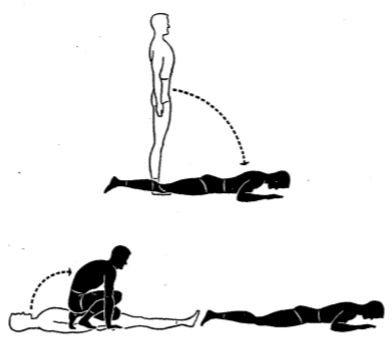
(a) Front. From a standing position, the men drop as quickly at possible to the ground in the prone position as for firing. If this command is given while the men are lying on their backs, they come up to the squatting position, thrust their legs backward, and assume the FRONT position as quickly as possible.
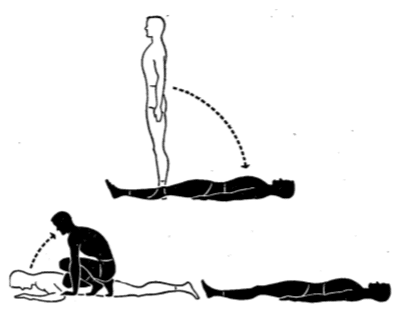
(b) Back. From the erect position the men drop instantly to the ground on their backs. If this command is given while the men are in the FRONT position they assume the BACK position as quickly as possible by pushing up with their arms and thrusting their legs forward between the arms.
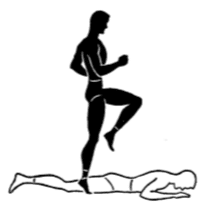
(c) Up. From either the FRONT or BACK position the men spring to their feet as quickly as possible and do a stationary run until the next command is given.
(2) RUNNING DRILL
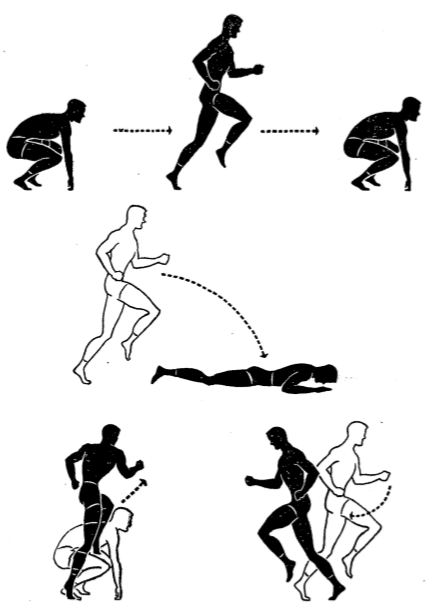
(a) Go and Stop. This type of drill is best executed with the men at 2 yard intervals in line formation. At the command: GO, the men charge forward as football linemen do in running signals. At the command: STOP, they stop and drop immediately to the linemen’s crouch. This GO and STOP sequence is rapidly repeated. It may be varied by interposing the commands FRONT and BACK (1 (a) and (b) above). Another variation is to command: RIGHT (or LEFT), at which the men charge at an angle of about 450 to the right (or left). The command: TO THE REAR is used to reverse the direction. A whistle is better than spoken commands for maneuvers of the GO and STOP variety.
(b) Zig-Zag Run and Drop. This exercise begins with the command: RIGHT (or LEFT). The men charge at an angle of about 45° to the right (or left). They continue running but with each single blast of the whistle they change direction by 45°. Two blasts of the whistle are the command to drop to the ground in the FRONT position ((1) (a) above). When the whistle next sounds, the men spring to their feet and continue the maneuver.
(c) Zig-Zag Run and Squat. This exercise is executed in the same manner as (b) above, except that on two blasts of the whistle the men come to a full squat with hands on the ground, instead of dropping to the ground.
(d) Zig-Zag. This command calls for a very wide straddle run. The men spring 3 or 4 feet laterally as well as forward with each stride. They spring from the right foot toward the left and from the left foot toward the right. Although this exercise is usually performed while running forward, it can also be done without forward progress.
(e) Cross Step Zig-Zag. On this command the men spring to their feet unless already standing and combine an exaggerated cross-over step with every 3 steps of an ordinary run. The cross-over step is executed by crossing in front of the right foot with the left foot or vice versa. The run is continued in this manner until the double blast of the whistle commands the men to drop to the ground.
(3) COMBINATION EXERCISES. It is often desirable to combine the grass drills (either the stationary or running type) with various conditioning exercises. These supplementary conditioning exercises should usually be done at a faster than ordinary cadence. The exercises most frequently used for this purpose are:
(a) Squat Thrust. This exercise may also be executed by thrusting legs diagonally to the rear, alternately to the left and right. When using it in conjunction with Grass Drills, repeat from 15 to 30 times.
(b) Sit Ups. From the BACK position and with arms stretched overhead, sit up, reach forward, and touch toes. Then recover to the supine position. About 20 sit ups is the usual dosage.
(c) Legs Overhead. From the BACK position with hands on the ground beside the hips, raise legs upward, then swing them backward over head until the toes are barely off the ground behind the head. Return legs to the starting position. Execute this movement in relatively slow cadence keeping the knees straight throughout.
(d) V-Up. Repeat from 10 to 20 times.
(e) Body Twist. Repeat from 12 to 20 times.
(f) Bicycle Exercise. From the BACK position raise the legs and hips. Keep elbows on the ground and support the hips with hands. Execute vigorously movements similar to those employed in pedaling a bicycle. Continue for 30 to 60 seconds.
Read the Entire Series
The Importance of Physical Fitness
Conditioning Exercises
Log Exercises
Strength Course
Guerilla Exercises






